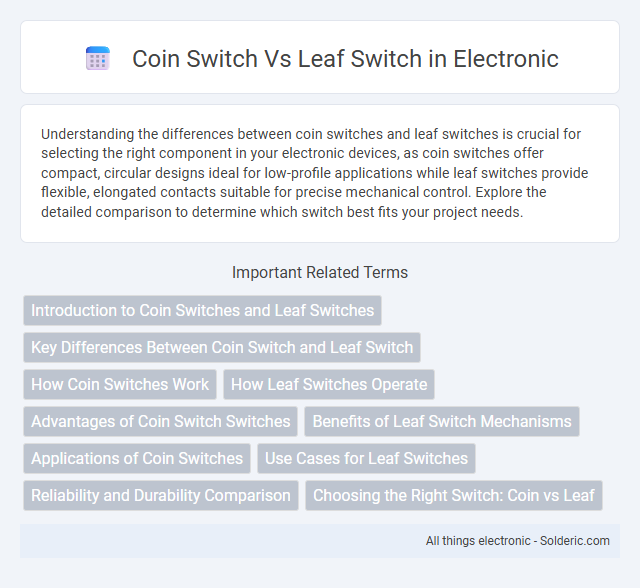Understanding the differences between coin switches and leaf switches is crucial for selecting the right component in your electronic devices, as coin switches offer compact, circular designs ideal for low-profile applications while leaf switches provide flexible, elongated contacts suitable for precise mechanical control. Explore the detailed comparison to determine which switch best fits your project needs.
Comparison Table
| Feature | Coin Switch | Leaf Switch |
|---|---|---|
| Purpose | Enables navigation or changes in state via coin-shaped actuator | Designed with leaf-shaped flexible contacts for low-force switching |
| Design | Tablet or coin-like compact mechanical switch | Flat, flexible leaf-like metal contacts |
| Actuation Force | Moderate; depends on coin contact mechanism | Low actuation force due to flexible leaf springs |
| Durability | Good mechanical lifespan, varies by material | High durability with robust leaf contacts |
| Common Applications | Vending machines, coin-operated devices | Keyboards, membrane switches, low-force input devices |
| Contact Type | Metal contacts arranged in coin form | Flexible, spring-like metal leaf contacts |
Introduction to Coin Switches and Leaf Switches
Coin switches and leaf switches are essential components in mechanical system controls, often used to regulate electrical circuits by detecting movements or positions. Coin switches typically feature a small, rounded actuator resembling a coin, which activates the switch through direct contact or pressure, while leaf switches operate using flexible, spring-like metal leaves that bend to close or open the circuit. Understanding the unique design and functionality of your coin switch or leaf switch helps optimize performance and ensure precise control in applications ranging from industrial machinery to consumer electronics.
Key Differences Between Coin Switch and Leaf Switch
Coin switches primarily operate by activating a mechanical or electronic mechanism when a coin is inserted, while leaf switches function through a simple electrical contact made by flexible metal leaves bending together. Coin switches are commonly used in vending machines and arcade games to verify currency, whereas leaf switches find applications in detecting position or limit in industrial machinery due to their durability and sensitivity. Your choice between these switches should consider the specific use case, whether requiring currency validation or reliable contact sensing in a compact design.
How Coin Switches Work
Coin switches operate by detecting specific coins based on size, weight, and metal composition using mechanical or electronic sensors. When the correct coin is inserted, the switch triggers an electrical circuit to activate a device or grant access, ensuring only valid coins are accepted. This method allows for precise control in vending machines and arcade games, preventing unauthorized use and ensuring reliable payment processing.
How Leaf Switches Operate
Leaf switches operate as the access layer in a leaf-spine network architecture, connecting directly to end devices and servers. They manage data traffic by forwarding packets to spine switches, which handle high-speed inter-switch communication, optimizing network scalability and performance. Your data flows efficiently through leaf switches that implement policies, VLANs, and security features to ensure seamless and secure access within the network.
Advantages of Coin Switch Switches
Coin switches offer precise and reliable switching mechanisms suited for arcade machines and vending devices, ensuring consistent performance and durability under frequent use. Their compact design enables easy installation in tight spaces, contributing to efficient machine layout and maintenance. Robust construction materials provide enhanced resistance to wear and environmental factors, reducing downtime and maintenance costs compared to leaf switches.
Benefits of Leaf Switch Mechanisms
Leaf switch mechanisms provide enhanced scalability by enabling seamless integration of multiple devices within data centers, supporting high-density port configurations. They reduce latency and improve network efficiency through direct server connections, minimizing bottlenecks commonly found in coin switch setups. This architecture simplifies management and increases fault tolerance, offering superior performance for modern cloud and enterprise networking environments.
Applications of Coin Switches
Coin switches are primarily used in vending machines, arcade games, and laundry machines for detecting and validating inserted coins, ensuring precise transaction handling. Their reliable mechanical design supports environments requiring robust, repeatable coin recognition and sorting. Your device benefits from the coin switch's ability to integrate seamlessly with payment systems in various automated service applications.
Use Cases for Leaf Switches
Leaf switches are primarily used to connect end devices such as servers, storage units, and access points within a data center or enterprise network, providing high-speed, low-latency access to network resources. They facilitate east-west traffic within a network fabric, optimizing performance for virtualization, cloud computing, and real-time applications. Leaf switches are essential in spine-leaf architectures, enabling scalable and efficient data center networks by managing data flows between servers and core switches.
Reliability and Durability Comparison
Coin switches offer high reliability with consistent electrical contact due to their solid metal components, making them durable in environments with frequent mechanical wear. Leaf switches, featuring thin flexible metal leaves, provide excellent durability in low-force applications but may experience contact degradation under heavy or rapid use. Your choice depends on the intensity and frequency of the switching operation, with coin switches generally outperforming leaf switches in long-term durability and mechanical reliability.
Choosing the Right Switch: Coin vs Leaf
Choosing the right switch between coin and leaf types depends primarily on the desired tactile feedback and actuation force for mechanical keyboards. Coin switches typically offer a smoother, quieter keystroke ideal for prolonged typing sessions, while leaf switches provide a more responsive and clicky experience favored by gamers and typists seeking precision. Understanding the actuation point, durability, and noise level of each switch type is crucial for optimizing keyboard performance and user comfort.
Coin switch vs Leaf switch Infographic

 solderic.com
solderic.com